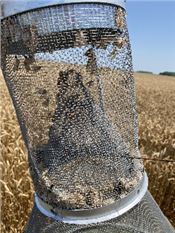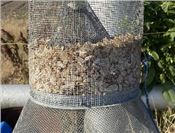Bollworm Numbers Up Compared To 2021; Farmers Urged To Scout
MARY HIGHTOWER
KEISER, ARKANSAS
If there was one phrase to sum up farming in Arkansas at the start of summer, it would be “keep scouting.”
Surveillance done by Cooperative Extension Service county agents around the state has found bollworm numbers up compared to 2021. Each year, agents post traps, and each month, they count the trapped insects as an indicator of what pests local farmers might expect to see in their fields.
Hungry bollworms can damage soybean pods, corn ears and cotton bolls and squares.
“These bollworm numbers have exploded it seems in the past two or three weeks,” said John David Farabough, Desha County extension agent for the University of Arkansas System Division of Agriculture. “I have traps spread from north to south borders in Desha County and all are running high numbers for this time of year.”
“Normally, at this time of year, I'm running 100 to 200 moths per trap per week,” he said. Now, “weekly trap counts are running 500 to 800 moths per trap per week.”
Farabough said he typically doesn’t see these numbers until late July or early August “when the corn in the area is drying out and then moths move into soybeans.”
Pretty big flight
“We are experiencing a pretty big bollworm flight. It does appear to be higher trap catches than what we were seeing at this time last year,” said Glenn Studebaker, extension entomologist and integrated pest management coordinator for the Division of Agriculture.
“We are seeing them primarily in soybean and grain sorghum right now, but I expect we will begin to see significant populations in cotton as well,” he said. “Growers need to be diligent in scouting susceptible crops for bollworm at this time.”
Studebaker said some areas are seeing more than 2,000 moths per seven- day catch.
“Reports are coming in of bollworm being found in flowering soybeans,” he said. “Some are picking up six to eight worms per 25 sweep sample in R2 soybeans.”
R2 is a reproductive stage at which soybeans are in full flower.
“Growers are encouraged to keep watch for bollworm larvae in susceptible crops such as soybean, grain sorghum or cotton,” Studebaker said. “It is likely with such high moth catches that we will see increased numbers in these crops.” ∆
MARY HIGHTOWER: University of Arkansas

Example of an insect trap set by county agents to help get an idea of the quantity of crop pests in a particular area. This one is in Jackson County, Arkansas.
U of A System Division of Agriculture photo by Matthew Davis

Bollworm moths in a trap in a photo taken July 1, 2022, in Jackson County, Arkansas. Agents and entomologists are seeing higher than usual numbers of these moths.
U of A System Division of Agriculture photo by Matthew Davis